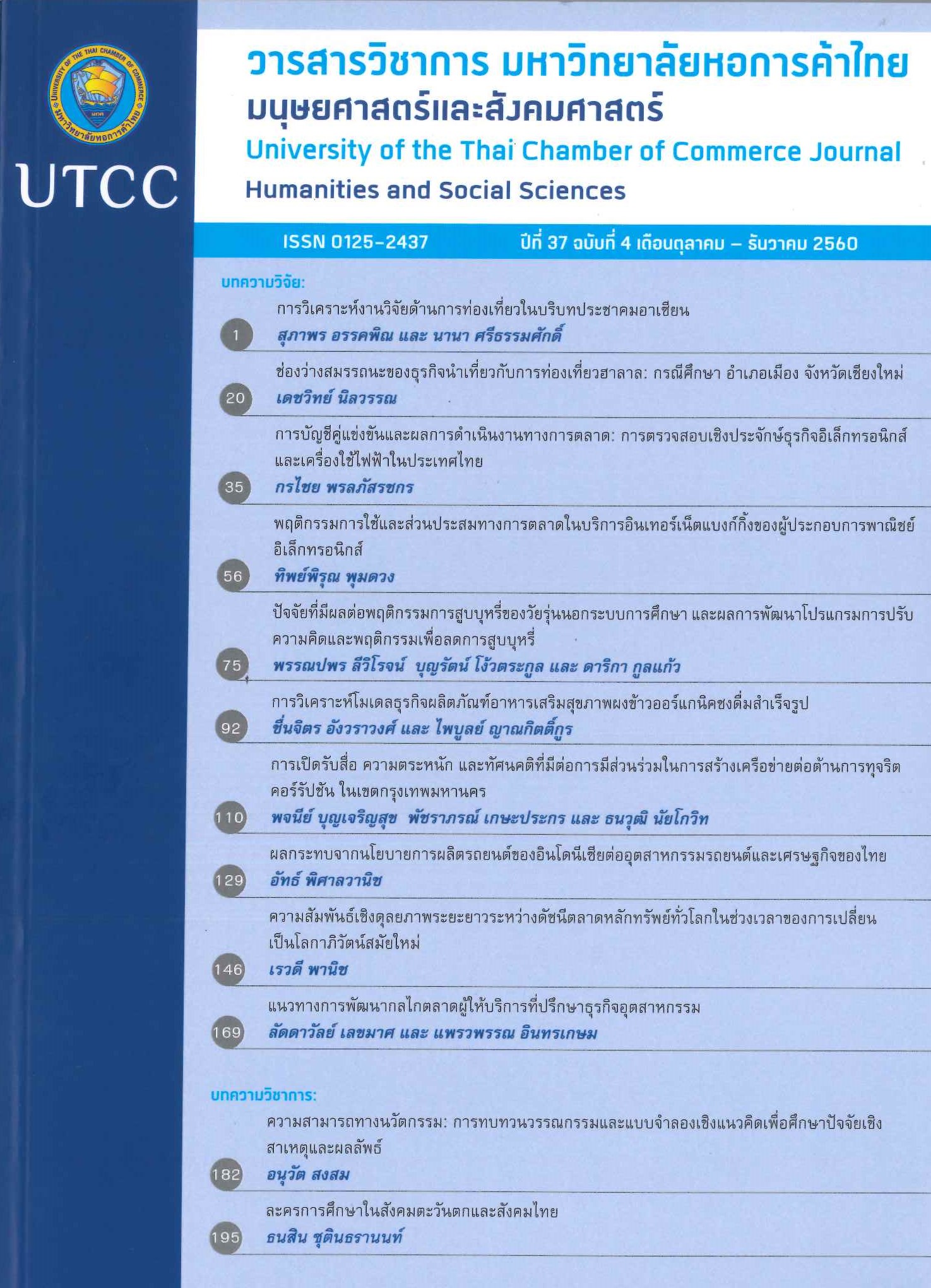Cointegrations amongst World Equity Market Indexes in Modern Globalization Era
Main Article Content
Abstract
This study is to investigate cointegration relationships among the equity markets of seven developed countries and five developing countries and emerging economics during the transitional period to modern globalization. The study applies cointegration analyses on monthly data of equity market indexes of the above countries. Based on Johansen (1988), this study tests the validity of long-run equilibrium and applies the Error Correction Model with Vector Error Correction Model to study short-run adjustments to long-run equilibriums. The main results include that before modern globalization (1976-1990) long-run cointegrations exist between USA (DJIA), Germany (DAX), Hong Kong (HSI), Malaysia (KLS) and Japan (NKY), Korea (KS11), Thailand (SET), Taiwan (TWSE), respectively. Deviating from a long-term relationship, NKY and TWSE have shot-tern corrections to long-run equilibrium. In modern globalization (1990-2016 USA (DJIA) and Germany (DAX) each cointegrates with FTSE, HSI, JKSE, KLS, STI and TWSE. Deviating from a long-term relationship, KLS, KS11, PSE, SET and TWSE have shot-tern corrections to long-run equilibrium. Therefore, there exist long-run relationships between US and German markets and those of developing countries and emerging economies.
Article Details
ลิขสิทธิ์ของบทความ
ผลงานที่ได้รับการตีพิมพ์ถือเป็นลิขสิทธิ์ของมหาวิทยาลัยหอการค้าไทย ห้ามมิให้นำเนื้อหา ทัศนะ หรือข้อคิดเห็นใด ๆ ของผลงานไปทำซ้ำ ดัดแปลง หรือเผยแพร่ ไม่ว่าทั้งหมดหรือบางส่วนโดยไม่ได้รับอนุญาตเป็นลายลักษณ์อักษรจากมหาวิทยาลัยหอการค้าไทยก่อน
References
Charoenkidhutakorn, K. (2005). The relationship between the stock exchange of Thailand index and the major indexes of the United States of America (Unpublished master’s
independent study). Chiang Mai University,Thailand. (in Thai).
Engle, R. F., & Granger, C. W. J. (1987). Cointegration and error correction: Representation, estimation and testing. Econometrica, 55(2), 251-276
Granger, C. W. J. (1981). Some properties of time series data and their use in econometric models specification. Journal of Econometrics, 16(1), 121-130.
Johansen, S. (1988). Statistical analysis of cointegration vectors. Journal of Economic Dynamic and Control 12(2-3), 231-254.
Johansen, S. (1995). Likelihood-based inference in cointegration vector autoregressive model. New York, NY: Oxford University Press.
Markowitz, H. M. (1987). Mean-variance analysis in portfolio choice and capital market. New York, NY: Blackwell.
Masih, A. M. M., & Masih, R. (1997). Modelling the dynamic linkages and the propagation Mechanism among major international stock markets: Empirical evidence from
the pre- and post-crash eras based on a multivariate cointegration/VECM approach. Quarterly Review of Economics and Finance, 37(4), 859-885
Masih, A. M. M., & Masih, R. (2002). Propagative causal price transmission among international stock market: evidence from the pre- and post-globalization period. Global Finance Journal, 13(1), 63-91.
Masih, R., & Masih, A. M. M. (2001). Long and short term dynamic causal transmission amongst international stock market. Journal of International Money and Finance, 20(4), 563-587.
Ophaschaowarit, N. (2005). The relationship between the stock exchange of Thailand index and The major indexes in European (Unpublished master’s independent
study). Chiang Mai University, Thailand. (in Thai).
Pradeeppawanij, R. (2011). Analysis of the relationship between the indexes of Thailand with the members of ASEAN (Unpublished master’s independentstudy). Bangkok University, Thailand. (in Thai)
Rangkakulnuwat, P. (2001). The demand of money in Thailand before and after the change in the exchange rate system: Error correction model. University of the
Thai Chamber of Commerce Journal, 21(3), 25-44. (in Thai).
Rangkakulnuwat, P. (2008). Determinant of foreign direct investment in ASEAN. University of the Thai Chamber of Commerce Journal, 28(1), 99-107. (in Thai).
Rangkakulnuwat, P. (2013). Time series analysis for economics and business. Bangkok, Thailand: Chulalongkorn University Press. (in Thai).
Ratanasumritkul, S., & Banchuenwijit, W. (2008). The relationship between the index prices, Stock Exchange of Thailand and the stock price index, foreign
exchange (Unpublished master’s independent study). University of the Thai Chamber of Commerce, Bangkok, Thailand. (in Thai).
Sheng, H.-C., & Tu, A. H. (2000). A study of cointegration and variance decomposition among national equity indices before and during the period of the Asian financial
crisis. Journal of Multinational Financial Management, 10(3-4), 345-365.
Somngam, P. (2003). The relationship between the stock exchange of Thailand index and the major index in Asia (Unpublished master’s independent study). Chiang Mai University, Thailand. (in Thai).
Uaapisitwong, T. (2007). The relationship between the stock exchange of Thailand index and the major indexes of the world (Unpublished master’s independentstudy). Chiang Mai University, Thailand. (in Thai).
Valadkhani, A., & Chancharat, S. (2008). Dynamic linkages between Thai and international stock markets. Journal of Economic Studies, 35(5): 425-441.
Wichairat, W. (2006). The relationship between the stock exchange of Thailand index and the major indexes in Oceania (Unpublished master’s independentstudy). Chiang Mai University, Thailand. (in Thai).
Wong, W.-K., Penm, J., Terrell, R. D., & Lim, K.Y. C. (2004). The relationship between stock market of major developed countries and Asian emerging markets. Journal of Applied Mathematics and Decision Sciences, 8(4): 201-2180

